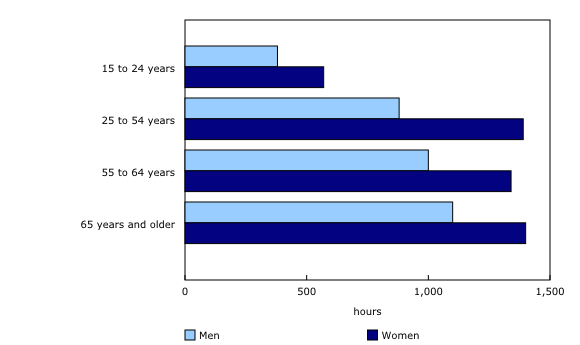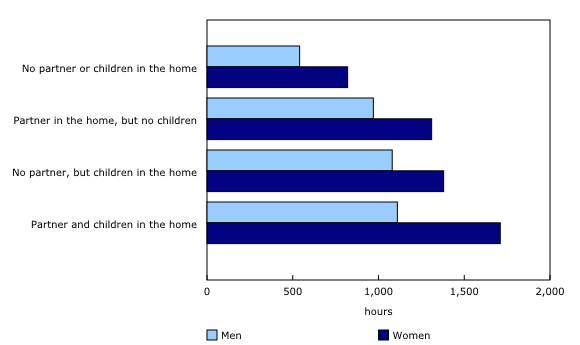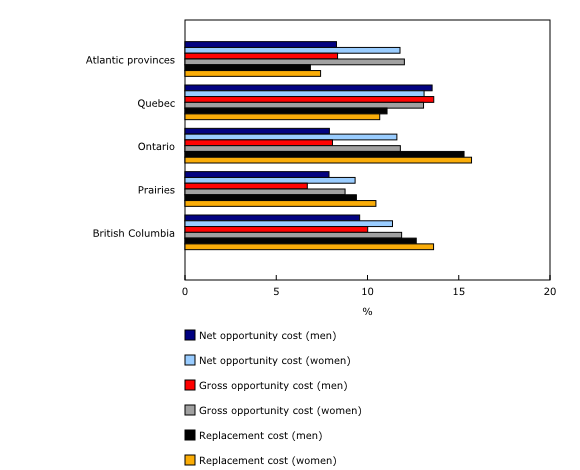Estimating the economic value of unpaid household activities in Canada, 2015 to 2019
Archived Content
Information identified as archived is provided for reference, research or recordkeeping purposes. It is not subject to the Government of Canada Web Standards and has not been altered or updated since it was archived. Please "contact us" to request a format other than those available.
Released: 2022-03-17
There is no doubt that the day-to-day household tasks that people do, such as cleaning, cooking, and caring for dependent children and adults, are productive activities. However, assigning economic importance to such activities can be challenging, as they are often done outside the market economy and therefore do not have an observable monetary value. Making an effort to estimate the monetary value of the unpaid household activities we all do each day is important in order to understand the true economic output or performance of a country and to highlight inequalities in society, such as pay gaps and differences between sexes in the contribution of various domestic and caregiving activities, which are often invisible to the broader society.
The study released today provides estimates of the economic value of unpaid household work in Canada for 2015 to 2019. By providing timely estimates of the economic value of unpaid household work, this study contributes to the discussion on inclusive economic performance and inequalities in the assigned economic value of certain people, jobs and activities in our society.
The COVID-19 pandemic has heightened the need to quantifying the value of unpaid household work by highlighting how important these activities are to the overall functioning of the Canadian society and economy and to the well-being of Canadians. The way we spend our time, the division of household work, as well as the balancing of work and caregiving activities have changed since the start of the pandemic. Although this study does not include estimates of the value of unpaid household work during the pandemic period, it can serve as a good baseline for making comparisons with the post-pandemic period, once those estimates are available.
The economic value of unpaid household work amounts to more than that of the manufacturing, wholesale and retail industries
The value of unpaid household work in Canada, based on a gross opportunity cost, rose to $860.2 billion or 37.2% of nominal GDP in 2019, which was larger than the total contributions of the manufacturing, wholesale and retail industries. On a per capita basis, the gross opportunity cost value of unpaid household work amounted to $34,370 in 2019.
The value of unpaid household work based on the replacement cost method also rose to $581.6 billion or 25.2% of nominal GDP in 2019. The per capita replacement cost value of unpaid household work was $23,240 in 2019, which represents the cost of having household work completed by hired replacements in the market economy.
The reason why the opportunity cost yields a larger value than the replacement cost method is because it includes the wages of all individuals and occupations in the economy, whereas the replacement cost only includes people in occupations who could carry out the household work that is normally unpaid. For example, the wages of high-paying jobs, such as doctors, engineers and lawyers, are included in the opportunity cost value, as the people who hold these jobs are assumed to forgo wages when they do unpaid household work. However, these high-paying jobs are not included in the replacement cost value, as the individuals in these jobs would not be hired to carry out household work that is normally unpaid. The lower replacement cost value estimated in this study indicates that society generally places less value on occupations that carry out household or domestic tasks, such as cleaning, cooking and caregiving, as these tasks are paid less in the market economy.
Women do the majority of unpaid household work but have a lower monetary value than men
While women continued to do the majority of unpaid household work, their share of the total monetary value of unpaid household work was less than the share of men. This difference between women's share of the hours and monetary value of unpaid household work is directly attributable to the market wage gap between men and women. For example, in 2019, women earned on average $0.88 for every dollar that men earned. However, a small decline in the wage gap between men and women was observed over the reference period of this study.
Women in all age groups spend more time on unpaid household work, while older men contribute more than younger men
Women's share of unpaid household work was largest for those between the ages of 25 and 54. One contributing factor to this larger share of household work is that women generally performed more of the caregiving duties for dependent children and adults than men, and these duties are most often performed between the ages of 25 and 54. Although women's average hours of unpaid household work remained relatively stable after the age of 25, their share of the total hours dropped after age 54, while the average hours for men increased for the older age groups.
The presence of children widens the gap in household work between men and women
Regardless of marital status and the presence of children, women tended to do more unpaid household work than men. In 2015, in households without children, women averaged 820 hours, compared with 540 hours among men. Several external studies looking into the reasons why women do more housework than men suggest that the differences are not due to men and women having different preferences or perceptions of cleanliness, but are rather driven by societal expectations placed on women to have clean homes. Once children are factored in, the hours of unpaid household work increased for both men and women.
For example, single fathers spent twice as much time on unpaid household work compared with single men. However, when there are children in partnered households (households with two adults), the gap between men's and women's share of household work widens, with women who do not have children contributing an average of 57.4% of hours, compared with 60.5% for women with children.
Women's household activities are valued less, even when valued with a market-based replacement cost
While inequalities between men and women are evident when looking at the hours spent doing unpaid household work and the associated opportunity cost values, there are also differences between the sexes when looking at the replacement cost values. Although the replacement cost method does not distinguish whether a man or woman is hired to carry out the household task, differences between men and women remain because of the type of activities they tend to do more often. For example, of the 20 unpaid household work activities included in this study, men spent the majority of hours on the following three tasks: outdoor maintenance; repair, painting or renovation; and taking out garbage, recycling, compost, and unpacking goods. The weighted average replacement cost for these activities was $23.74 per hour in 2019, while the replacement cost for all other activities in which women had the larger share was $17.62 per hour. This difference indicates that activities generally done more often by women in the home are paid less in the market economy than tasks or jobs more often done by men in the home and in the economy. This again signals a fundamental difference in the value of work done by women in the home, but also a market wage gap between jobs done more by women than by men.
Regional differences in wages affect the monetary value of unpaid household work
Although residents of the Atlantic provinces spent the most time on average doing unpaid household work compared with the other regions across Canada examine, the value of their household work was the lowest for the gross opportunity cost, the net opportunity cost and the replacement cost, due to lower average wages in these provinces. Meanwhile, the Prairies had the largest average value of unpaid household work per person thanks to relatively high average unpaid household work hours and higher wages.
Women's share of hours of unpaid household work is similar across Canada
In the five regions of Canada examined in this study, women had a similar share of hours of unpaid household work, ranging from a low of 58.7% in British Columbia to a high of 61.3% in Ontario.
During the study period, growth in women's wages outpaced that of men's in all regions except Quebec, regardless of the valuation method. Nonetheless, the difference is small and the wage growth in Quebec was strongest in the regions based on gross and net opportunity cost. On a replacement cost basis, wages grew the most in Ontario and the least in the Atlantic provinces.
Sustainable Development Goals
On January 1, 2016, the world officially began implementation of the 2030 Agenda for Sustainable Development—the United Nation's transformative plan of action that addresses urgent global challenges over the next 15 years. The plan is based on 17 specific sustainable development goals.
Estimating the economic value of unpaid household work is an example of how Statistics Canada supports the reporting on the Global Goals for Sustainable Development. This release will be used in helping to measure the following goal:

Note to readers
The study released today provides estimates of the economic value of unpaid household activities in Canada for 2015 to 2019.
The study was funded by Women and Gender Equality Canada.
All values are expressed in nominal dollars.
The full paper, including data tables, can be found in "Estimating the economic value of unpaid household work in Canada, 2015 to 2019", Latest Developments in the Canadian Economic Accounts (13-605-X), 2022.
Opportunity costs can be estimated as both gross (before tax) and net (after tax). The gross opportunity cost can be viewed as the "social opportunity cost" of unpaid household work, as potential market output would be less when individuals forgo paid work to perform unpaid household activities. On the other hand, the net opportunity cost reflects a "private cost" as it measures the forgone earnings of the individual.
Products
The document, "Estimating the economic value of unpaid household work in Canada, 2015 to 2019", which is part of Latest Developments in the Canadian Economic Accounts (13-605-X), is now available.
The Economic Accounts Statistics portal, accessible from the Subjects module of our website, features an up-to-date portrait of national and provincial economies and their structure.
The User Guide: Canadian System of Macroeconomic Accounts (13-606-G) is available.
The Methodological Guide: Canadian System of Macroeconomic Accounts (13-607-X) is available.
Contact information
For more information, or to enquire about the concepts, methods or data quality of this release, contact us (toll-free 1-800-263-1136; 514-283-8300; infostats@statcan.gc.ca) or Media Relations (statcan.mediahotline-ligneinfomedias.statcan@statcan.gc.ca).
- Date modified:




